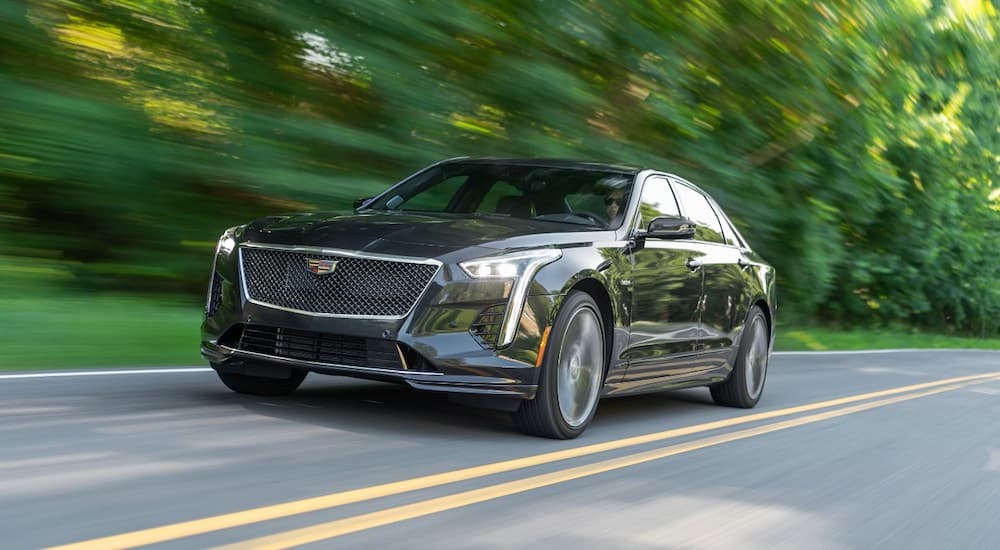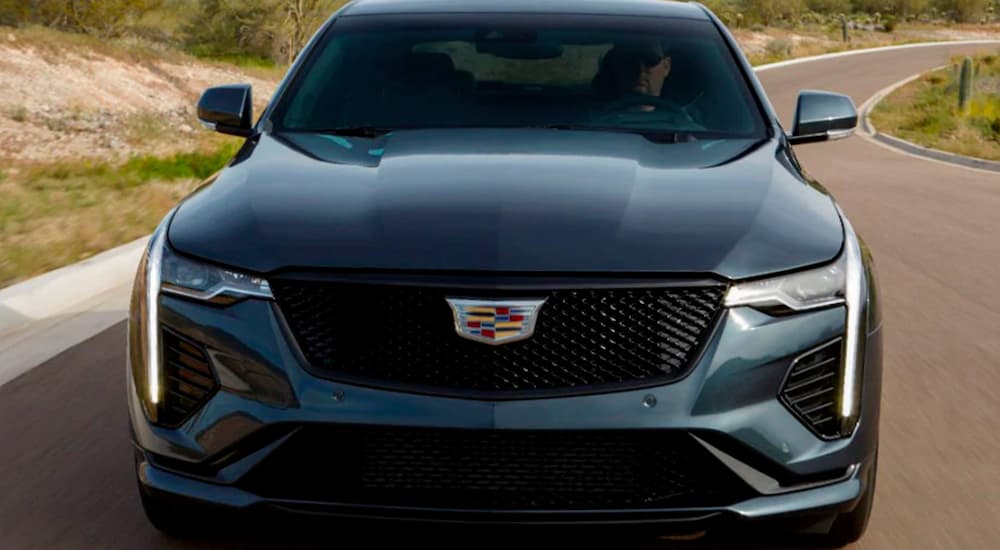Drivers have long been drawn to Cadillac thanks to the brand’s reputation for quality construction and unsurpassed luxury. Truly the foremost American luxury brand, over the years, Cadillac has proven that it can hold its own when it comes to providing high-end interiors, refined styling, and alluring creature features. Of course, these superlatives are only half the battle, as any driver visiting a Cadillac dealer is going to expect a vehicle that offers the performance to match its rarefied luxury credentials. This all begs the question, which Cadillac has the best engine?
This is a tricky question because it has an answer that’s both easy and inconvenient: the Cadillac CT6-V, a full-size luxury sedan that the brand only produced for a tragically short two-year period between 2019 and 2020. The CT6-V, a high-performance version of the CT6, featured the first twin-turbo V8 in the company’s history: the Blackwing, a 4.2-liter V8 with two twin-scroll turbochargers. The engine was a departure for Cadillac, which for the first time in recent memory, wasn’t squeezing a ready-made Chevy engine under the hood but rather developing its own design from the ground up.
Unfortunately for the Blackwing and gas-guzzling V8 fans everywhere, the engine was developed during a time of shifting priorities at GM. Sales were never through the roof to begin with, and as GM looked to make the switch to an all-electric lineup by 2035, it was difficult to see where the thirsty Blackwing fit in. The Detroit factory that was home to the CT6 was converted to play a bigger role in the brand’s all-electric future, and in the end, GM pulled the plug after producing fewer than 1,500 units. While its time on this Earth might have been brief, there’s no denying the impact the Blackwing made in its short time on the market. Let’s take a look back at what made the engine so special and see if its successor, the 6.2-liter Blackwing V8, can do the name proud.
Starting From Scratch
The original Blackwing engine was part of Cadillac’s plan to give the established European luxury brands a run for their money. Cadillac hired storied auto executive Johan de Nysschen away from Infiniti, who made a major impact on his arrival with the announcement of a $12 billion project to expand Cadillac’s presence in the luxury market, especially in the U.S. and China.
Under de Nysschen’s leadership, the CT6 debuted in 2015 as the first vehicle to be built on Cadillac’s new Omega platform. This new platform was key in dethroning Cadillac’s European rivals thanks to its ability to accommodate a larger luxury sedan that handled like a much smaller, more spritely vehicle. This put models like the BMW 5 Series directly in Cadillac’s sights, with the aluminum-heavy CT6 able to offer more responsive performance despite its larger size. This still wasn’t the CT6 we know today, as the 2015 version featured a turbo four-cylinder and two V6 options, but it was well on its way.
Cadillac teased drivers in 2016 with a concept Escala sedan that featured the Omega platform from the CT6 paired with a 4.2-liter twin-turbo V8. The concept car was an intriguing experiment, but the project was abandoned as sedan sales continued to fall in favor of increasingly popular crossover SUVs. Cadillac did make a play for an Omega-based crossover but lacked the engineering power to get the job done as GM as a whole focused on growing its own pickup and crossover lineup. de Nysschen’s tenure at Cadillac would be short-lived as the executive and GM didn’t see eye-to-eye when it came to the brand’s future, but he had one surprise on his way out the door in 2018: a CT6 with the Blackwing V8 engine.
The Original Blackwing
The original Blackwing V8 was unlike any other engine in GM’s lineup. Spiritually much closer to the premium engines found on top-tier German luxury models, the twin-turbo V8 featured an aluminum block and heads and dual throttle bodies. In the CT6 Premium Luxury model, this amounted to some 500 horsepower and 574 lb-ft of torque, but the CT6-V model is where the engine was truly able to shine. When paired with the high-performance version in the CT6-V, the Blackwing was able to produce 550 horsepower and a mind-blowing 640 lb-ft of torque.
The Blackwing V8 was the perfect compliment to the Omega platform, becoming the luxury engine that the luxury platform had long been searching for. The Blackwing featured two twin-scroll turbochargers with titanium aluminide turbines moving at speeds of up to 190,000 RPM. This allows the turbos to produce a peak boost pressure of 20 psi, which is then dealt with by electronic wastegates that regulate the boost pressure by diverting excess exhaust gasses away from the turbine.
The intercoolers were another unique, high-performance feature: mounted above the cylinder heads, these were able to reduce the air temperature by more than 120 degrees to allow cooler, oxygen-rich air to reach the air intake. With a V8 under the hood, the CT6-V was never going to be the most efficient sedan on the road, but Cadillac addressed this to some degree by including cylinder deactivation and variable camshaft timing.
With a next-generation power plant, things were looking good for the Blackwing-equipped CT6-V until suddenly they weren’t. The rise of the crossover SUV is an undeniable trend in today’s auto industry, and as the style’s popularity began to grow, automakers had to take a long, hard look at some of their niche sedan projects. The CT6 was one such victim, with the sedan and its Omega platform falling by the wayside and ceasing production in 2020.
Twins for the Win
Perhaps the most game-changing feature on the original Blackwing was the engine’s double twin-scroll turbochargers. This type of turbocharger offers a major advantage over the single-scroll version found on many high-performance vehicles, and it all comes down to how it handles exhaust. For simplicity’s sake, let’s use a four-cylinder engine (or half of a V8) as an example. In a typical engine, the crankshaft rotates two times––720 degrees––every time a cylinder fires. On a four-cylinder engine, this means you can take that 720 degrees of crankshaft rotation and divide it by the number of cylinders to determine that a cylinder will fire every 180 degrees of rotation.
The problem with single-scroll turbos arises from the fact that, owing to the way the engine is designed, each cylinder’s exhaust valves might stay open longer than it takes for the crankshaft to rotate 180 degrees. This means that one cylinder’s exhaust valve will still be open when the next cylinder in the rotation opens its own exhaust valve, resulting in exhaust from the recently-fired cylinder flowing back into the previous cylinder. This backflow will mess with the intake of the previous cylinder as it prepares for its next firing, which can have a noticeable impact on performance.
The Blackwing engine solves this problem thanks to its twin twin-scroll design, which divides the exhaust into two separate channels to prevent this type of overlap. This means that instead of having a window of 180 degrees between cylinder firings, it’s doubled to 360 degrees, which drastically reduces this sort of performance-hindering backflow. Again, imagine a four-cylinder engine that fires in a rotation of 1-3-2-4. Previously the exhaust from cylinder 3 would be prone to escaping back into cylinder 1, but now since the cylinders have different manifolds, there’s no direct route between cylinders 1 and 3. By reducing this type of exhaust overlap, the Blackwing engine is able to offer better efficiency and response as the turbocharger is better able to spool up quickly at lower RPMs.
Black To The Future
With the demise of the Blackwing, a new challenger has stepped up to the plate at Cadillac. Based on the Chevy LT4 engine that debuted in the 2015 Corvette Z06, this supercharged 6.2-liter V8 retains the Blackwing name, if not the features. Instead of dual twin-scroll turbochargers, the new Blackwing features a single Roots-type twin-screw supercharger with 10 PSI of boost to the original Blackwing’s 20 PSI. In addition to the CT5-V, the new engine can be found on various Cadillac models, from the 2016-2019 CTS-V to the upcoming Escalade-V.
Reserved for the brand’s ultra-high-performance vehicles, the LT4 is based on Chevy’s fifth-generation of naturally-aspirated small block engines, increasing the output through the use of forced induction techniques. Despite the absence of certain components, the new 6.2-liter Blackwing more than holds its own. In fact, one of the luxury sedans that it’s been paired with, the CT5-V, has officially become Cadillac’s fastest-ever production vehicle with its considerable 668 horsepower and 659 lb-ft of torque allowing it to reach zero-to-60 in just 3.6 seconds.
There are a few areas where the 6.2-liter outshines its 4.2-liter predecessor, starting with responsiveness. The newer Blackwing features longer, more stretched-out cylinders than the previous iteration, which result in a higher-revving and more engaging feel. The 6.2 also has a larger displacement than the 4.2, but it is more compact. With a shorter path for the airflow to navigate, the newer Blackwing is unmatched in terms of responsiveness, giving drivers a crisper connection behind the wheel.
The decision to ditch the original Blackwing’s dual turbos in favor of a single supercharger further amps up the new CT5-V’s responsiveness. Turbochargers use energy from exhaust gasses for power which, while a plus in terms of efficiency, limits the components to a certain extent. Superchargers, on the other hand, draw their energy directly from the engine. This does take a toll on efficiency but really opens the door in terms of engine response. Given the ways in which the new Blackwing lags behind the original, we’re glad to see Cadillac has chosen performance over efficiency in this particular case.
The Best Cadillac Engine…Ever?
Of course, since Cadillac is a GM brand, the new Blackwing likely isn’t long for this world, at least not in its current form. The same ambitious emissions goals that spelled doom for the original Blackwing will eventually see Cadillac go entirely electric by 2035, making the beefy V8 and the like instant collector’s items.
When it comes to engines, there’s no one-size-fits-all option. Some drivers are going to value efficiency over power, while others just want to see how many Gs they can pull going into a turn. Cadillac’s Blackwing engines, while not the most efficient designs in the world, do offer power in spades, with the 6.2-liter and 4.2-liter versions both delivering ample horsepower.
The original Blackwing, with its dual twin-scroll design, brought some innovative technology into play and was a successful, if short-lived, venture, especially given that it was Cadillac’s first-ever in-house design. While the future of the 4.2-liter Blackwing is in question, it’s exactly the type of powerful V8 Cadillac needs to compete with BMW, Mercedes-Benz, and the like. One look inside the interior of a CT5-V Blackwing will tell you that there is no doubting Cadillac’s luxury credentials, and with an engine like the 6.2-liter under the hood, there’s no reason to think that Cadillac can’t snatch the crown from its European competitors.






